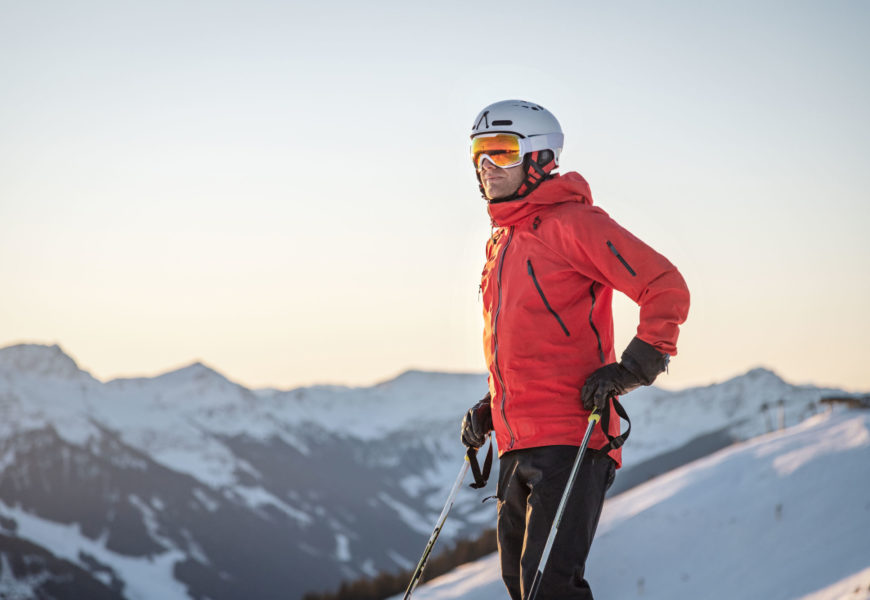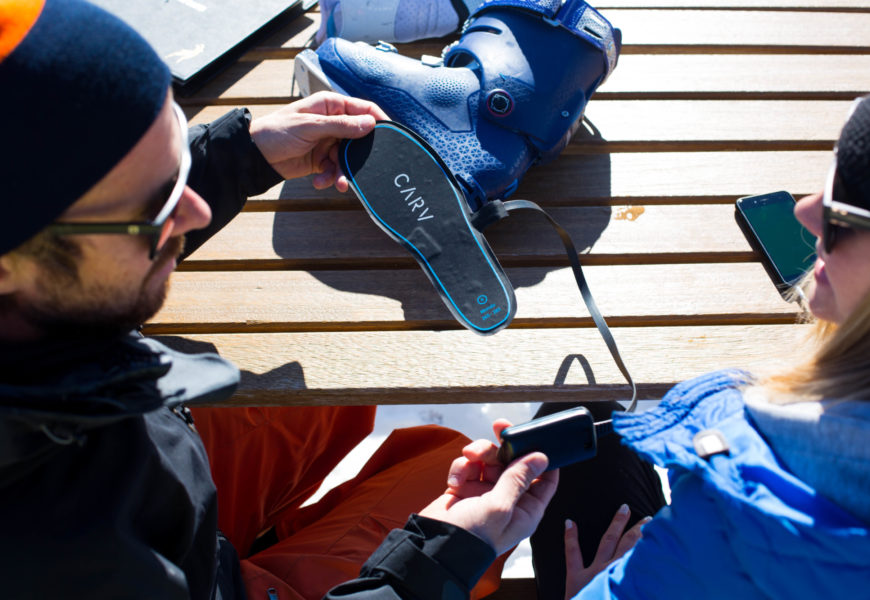How To Ski On Ice: 10 Steps For Skiing On Icy Slopes

Votes:
Ice.
You don’t even have to say it...
You can just make the noise and any skier is instantly transported to a time they ended up on a slope they weren’t quite prepared for.
Skiing on ice is challenging, it’s scary and unfortunately, it’s a fact of (skiing) life. You’d be hard-pressed to spend a week of skiing anywhere without coming across icy conditions at least once.
Since ice is inevitable, we need to learn to handle it and maybe even enjoy it. Ask any skier who reached the upper echelons of ski racing and they’ll tell you:
All that icy speed becomes a lot of fun once you make yourself at home there!
How are icy slopes formed?
True icy slopes form when the snow melts and then freezes.
However, there are plenty of other situations that can create slippery conditions under foot:
- Classic icy pistes can be found on spring mornings when yesterday’s slush was groomed and frozen overnight.
- Wind packed snow can often be found on very steep slopes, where new snow is easily blown or scraped off.
- The end of a powder day usually brings slippery conditions. Fresh snow gets very densely packed down, resulting in a glass-like sheen on the surface that makes it very difficult to grip.
- Towards the end of the day, the pistes can get very icy, particularly if there hasn’t been snowfall for a while. The fresh grooming is pushed into sugary piles on the side of the slopes by skiers and riders, exposing the hard icy base below.
Regardless of the cause, anytime you stand on snow with little or no give in it, there are tactics and techniques to consider.
Avoid skidding and losing grip on the ice by engaging your edges earlier in the turn
The challenges of skiing in icy conditions
Skiing on ice is hard… figuratively and literally.
There are two main challenges that you NEED to be aware of...
1. Speed
When your skis don’t sink at all into the surface, they pick up speed very quickly, especially when there’s a shiny frozen layer on the top.
This acceleration means everything seems to come at you very quickly, and with higher speed comes more pressure when you engage the edges in the snow.
2. Lack of grip
Most snow compresses slightly when you stand on it, so when you tip your skis on edge, they sink a little into the snow, creating a platform for you to stand on while you make a turn.
Ice is slippery and very firm, so rather than compacting snow to make a ledge, you have to balance on a knife-edge. Those few millimetres of metal on the edge of your ski are all that will penetrate the surface.
Ice does the same thing to all of us; as soon as we’re out of our comfort zone, all the bad habits come rushing back.
Sometimes, all it takes is the sound of another skier scraping across the ice to have a competent skier leaning inside to hug the hill and rocking back onto the tails of the skis.
How to ski on ice (10 steps)
- Don’t make sudden movements
- Learn to balance against your outside ski
- Practice skiing with a stable stance
- Start with a skid to get down safely
- Use your edges for direction
- Stack your weight against the outside ski
- Read the surface
- Listen to your skis
- Tune your skis
- Start to carve on ice (expert)
1. Don’t make sudden movements
Hard packed snow pushes back on you the moment you stand on it, so every move you make has instant consequences.
To get to grips with this make slow, deliberate, gradual movements: just like driving on ice. A small change in your stance can have a big effect on the skis. Don't make knee-jerk reactions
2. Learn to balance against your outside ski
Here’s the key to staying on your feet on the ice. Standing on the outside ski is important in any situation, but it becomes essential when the slope gets icy.
Any time the skis want to slide away from the body, bringing the weight over the outside foot means you simply slide with them.
And when you do want to add a bit more grip, you need to stand so all your weight is pushing that knife-edge into the ice, rather than down the hill and away from you.
Carv Tip: Learn to balance against your outside ski
If you're skiing with Carv, you'll see exactly how much you pressure your outside ski. To help you out, Carv will recommend drills and tips to help you ski with the right movements. Here are 2 of our favourites:
- Outside Ski Turns Drill - As you ski, you'll get an audio sound every turn if you are balanced against your outside ski. Aim to get to level 15 or higher to be truly confident mastering the ice.
- Outside Ski Pressure Monitor - Hear a continuous feed of your outside ski pressure in your ear every turn. Try to stay above 60% - hearing it live will help you understand what it feels like when you are getting it right

3. Practice skiing with a stable stance
As grip gets harder and harder to find, we can do four things to help us ski with control...
i) Set a wider base on the hard ice
Ice is not the place to ski with your feet glued together. A wider stance, at least as wide as you would stand naturally on an unstable floor, will give you a fighting chance.
ii) Lower your centre of mass
You want a mobile and athletic stance.
There should always be some bend in your ankles, knees and hips. Imagine getting ready to jump or trying to land a jump without making any noise. A wide athletic stance should already have you feeling more confident sliding around on the ice.
The bonus is this unlocks all the lateral range of movement in your legs, allowing you to edge the skis without leaning the body up the hill.
iii) Focus on your fore-aft balance
As the skis speed up it’s easy to end up hanging over the tails and they drag you along.
Pulling the feet back underneath you and raising your hips should bring the shins in contact with the front of the boots. This puts you back in the driving seat; you want to feel this contact before you start each turn.
iv) Keep your hands up
Keeping your hands up in front can help bring the shoulders forward over your toes and encourage a bend at the hips.
4. Start with a skid to get down safely
When we hit an icy section, the skis are going to slide, so the first thing we need to learn is how to control it. Side-slip straight down the hill and then pivot the skis to slide facing the other way.
Then follow these steps:
- Try to skid while balancing on your downhill foot. When you get comfortable, try lifting the tail or the whole of the inside ski; see if you can do it without moving anything else.
- Your speed control here is your edges. Try edging and flattening the skis and see what it does to your speed. Rolling the ankles and knees into the hill should allow you to tip the skis without disrupting your balance.
- Can you slide for a bit and come to a crisp stop using those edges?
5. Use your edges for direction
Once you’ve mastered using the edges of your skis while balanced, it’s time to put them to a different use: direction change.
Here’s how:
- Make the same edging move slightly earlier in the turn, with the skis facing 10 or 2 o’clock rather than all the way across the hill. As well as slowing the skis down, the added grip should start to steer you across the hill.
- Find the blend between skidding for speed control and gripping for direction change. It’s very rare that you want to be 100% one or the other. Every turn I make on ice is a mixture of carving and sliding.
Once you can accept that some slide slipping is inevitable while you make a turn this becomes fun. Think of it like driving a rally car – the car rarely moves in the direction the lights are facing.
When you get a feel for the slide you can anticipate it and use it to help get you where you want to go. If you get confident playing around with different turns like this, you can progress through the next few steps...
6. Stack your weight against the outside ski
When we get caught out or surprised on the ice most of us tend to freeze up, and when trying to balance on the outside ski there is a tendency to lock up and push into the outside leg.
This position, braced against the ski is not athletic or responsive. It tends to push the upper body to the inside and as you pick up speed the skis are likely to chatter.
The goal instead is to balance by stacking the bones over the outside foot and keeping an athletic stance.

Your body position must stay loose with your weight balancing against the outside ski.
Being supported by your skeleton like this gives you structural integrity without having to hang on for dear life and allows the muscles to stay a little loose so you can adjust your stance as the surface changes.
7. Read the surface
No hill is a completely uniform sheet of ice (unless you’re the first one on it in the morning and it really has frozen solid). As the weather hits and skiers slide around, variations will start to appear in the snow.
If you spend enough time looking ahead in this environment you will start to notice the changes in the snow, from the mini ice rinks to the little patches of more ‘grippy’ snow. You should always take this into account when choosing a line:
- Any time you want to edge the skis a lot in a short space of time, aim for an island of softer snow
- When you hit a really slick patch just get balanced over the outside foot and go for a slide – you will find some purchase on the other side.
8. Listen to your skis
That loud scraping noise tells you a lot about how the skis are performing on the snow. Slam on the brakes and it will get loud quickly, whereas smooth turns and progressive movements will build the noise gradually.
Learn to interpret the sound from the snow so you have you an extra piece of feedback.
9. Tune your Skis
A clean and sharp set of edges certainly makes it easier to hold an edge on firm snow, so tune your skis regularly.
Before you start blaming your tools though, remember that balance is a lot more important than a sharp set of planks!
10. Start to carve on ice (experts only)
To go full Ted Ligety takes an incredible amount of work and expertise.
It is worth working towards though, as holding an edge on a steep icy slope is an exhilarating and rewarding feeling, and it will do wonders for your confidence on regular snow. You need to master everything mentioned above and then slowly start pushing the pace up when you link turns together.
Here are a few hints to help along the way...
- Skiing at speed on ice takes a lot more strength, as well as finely honed balance. You should be comfortable making fast turns purely on the outside ski on a soft groomer before you start.
- The pressure will really start to build up under the outside ski in the second half of the turn. To stand strongly against this you need to learn to bend at the hips to edge the skis while balancing to the outside, rather than just the ankles and knees.
Skiing at this speed is done by feel. You need to develop the touch to make micro-adjustments mid-turn.
Here’s how...
- If you feel the skis are tending to slide you need to shift the centre of mass to the outside.
- If the tail of the ski is washing away down the hill (a down-stem) you need to move the centre of mass slightly back over the heels.
- If you feel balanced solidly against the groove your skis carve in the snow you can move the hips inside to create a higher edge angle.
Troubleshooting (drag your ski poles)
Dragging the pole tips in the snow will ensure you stay flexed and athletic. Particularly the downhill pole!
Reaching down the hill to keep this pole on the ground at all times will help bring the upper body over the downhill ski so you find more grip (your hands should be pushing forward while you do this).
This exercise should give you back some control and give you an idea of where you’re going wrong.
Confidently cruising over the ice is a surefire way to show your mastery of skiing. Plus, it's a lot more fun to ski knowing you are not about to slide off the piste.
Want to build your confidence on the ice this season? See how Carv could help you.


